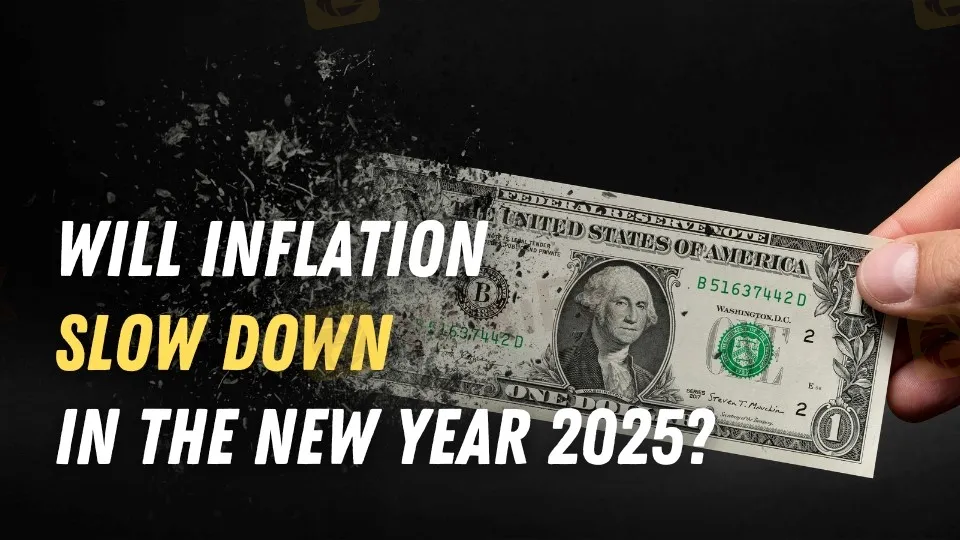简体中文
繁體中文
English
Pусский
日本語
ภาษาไทย
Tiếng Việt
Bahasa Indonesia
Español
हिन्दी
Filippiiniläinen
Français
Deutsch
Português
Türkçe
한국어
العربية
Will Inflation Slow Down in the New Year 2025?
Abstract:Will inflation slow down in 2025? Experts weigh in on projections, economic policies, and potential impacts, offering insights into what the new year may hold.

Inflation dominated economic debates in 2024, and analysts say it will be a major worry in 2025. Inflation projections vary greatly, affected by economic policy, global trade dynamics, and consumer behavior. The Federal Reserve and independent economists have provided several projections, providing a complicated picture of the coming year.
Inflation Forecasts for 2025
The Federal Reserve expects core Personal Consumption Expenditures (PCE) inflation to reach 2.5% in 2025, then fall to 2.2% in 2026, and converge with the long-term target of 2% by 2027. Bloomberg polled independent economists, who were slightly less hopeful. While they agree on a 2.5% core PCE inflation rate in 2025, they expect a slower decrease, with inflation settling at 2.4% in 2026.
President-elect Trump's economic proposals, including tariffs on China and other trading partners, probable immigration restrictions, and corporate tax cuts, have been flagged as possibly inflationary. These actions have the potential to aggravate price pressures and delay consumer relief.

Diverging Economic Outlooks
Some analysts, notably Nobel Prize-winning economist Joseph Stiglitz, are more pessimistic. Stiglitz has warned of a potential “inflationary spiral” that could result in retaliatory trade wars, impacting economic development. Similarly, BNP Paribas predicts that inflation will climb sharply from late 2025 to 2026. The Consumer Price Index (CPI) is expected to rise to 2.9% by the end of 2025 and 3.9% by the end of 2026, according to the BNP. The business also anticipates the Federal Reserve to keep interest rates unchanged until 2025, with no monetary easing.
Deutsche Bank shares the BNP's prediction, while other Wall Street firms anticipate two to three rate cuts in 2025, which is more in line with the Federal Reserve's projections. This discrepancy highlights the uncertainties surrounding inflationary trends.
Consumer and Market Effects
Consistent price increases in industries such as housing, insurance, and healthcare are likely to keep consumer spending under pressure. Shelter costs are likely to fall slightly in 2025, but they may stay high, adding to sticky inflation in the services sector. This could result in minimal respite for everyday bills.
There are certain advantages, though. The US economy has exhibited amazing resiliency, with strong growth, healthy consumer spending, and low unemployment rates giving a solid platform for 2025.
Final Thoughts
While estimates vary, the agreement is that inflation will be a significant issue in 2025. Key factors influencing price trajectory include trade policy, labor market developments, and Federal Reserve decisions. As consumers and businesses negotiate the uncertainty of the new year, they will need to keep an eye on these trends.

Disclaimer:
The views in this article only represent the author's personal views, and do not constitute investment advice on this platform. This platform does not guarantee the accuracy, completeness and timeliness of the information in the article, and will not be liable for any loss caused by the use of or reliance on the information in the article.
Read more

InterTrader Exposed: Traders Report Unfair Account Blocks, Profit Removal & Additional Fee for Withd
Does InterTrader block your forex trading account, giving inexplicable reasons? Does the broker flag you with latency trading and cancel all your profits? Do you have to pay additional fees for withdrawals? Did the UK-based forex broker fail to recognize the deposit you made? Does the customer service fail to address your trading queries? In this InterTrader review article, we have shared such complaints. Read them out.

Grand Capital Doesn’t Feel GRAND for Traders with Withdrawal Denials & Long Processing Times
The trading environment does not seem that rosy for traders at Grand Capital, a Seychelles-based forex broker. Traders’ requests for withdrawals are alleged to be in the review process for months, making them frustrated and helpless. Despite meeting the guidelines, traders find it hard to withdraw funds, as suggested by their complaints online. What’s also troubling traders are long processing times concerning Grand Capital withdrawals. In this Grand Capital review segment, we have shared some complaints for you to look at. Read on!

ADSS Review: Traders Say NO to Trading B’coz of Withdrawal Blocks, Account Freeze & Trade Issues
Does ADSS give you plenty of excuses to deny you access to withdrawals? Is your withdrawal request pending for months or years? Do you witness account freezes from the United Arab Emirates-based forex broker? Do you struggle to open and close your forex positions on the ADSS app? Does the customer support service fail to respond to your trading queries? All these issues have become a rage online. In this ADSS Broker review article, we have highlighted actual trader wordings on these issues. Keep reading!

INGOT Brokers Regulation 2025: ASIC vs Offshore License - What Traders Must Know
Explore INGOT Brokers regulation in 2025: Compare their ASIC and Seychelles FSA licenses, understand trader protection levels, and learn about potential risks in this detailed guide.
WikiFX Broker
Latest News
Mitrade Arabic Platform Targets MENA Gold Trading Boom
Israeli Arrested in Rome Over €50M Forex Scam
New FCA Consumer Alert 2025: Important Warning for All Consumers
EmiraX Markets Withdrawal Issues Exposed
Consob Targets Political Deepfake “Clone Sites” and Unlicensed Platforms in Latest Enforcement Round
WikiEXPO Global Expert Interviews: Gustavo Antonio Montero: ESG in Finance
Scam Alert: GINKGO-my.com is Draining Millions from Malaysians!
The Debt-Reduction Playbook: Can Today's Governments Learn From The Past?
INGOT Brokers Regulation 2025: ASIC vs Offshore License - What Traders Must Know
Is Upforex Safe or a Scam? A 2025 Safety Review Based on Facts
Currency Calculator



